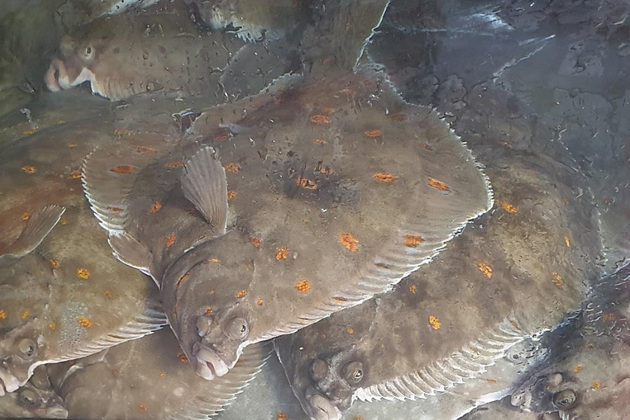LogFlat
Logistics solutions for flatfish

This project investigates the optimal ways to collect and handle flatfish in Norway, focusing on both live and chilled raw materials. We will develop a practical guide for the seafood industry, offering recommendations for the catching, handling, storing, and packaging of flatfish.
Start
01. Aug 2025
End
31. Dec 2026
Funded by
Norwegian Seafood Research Fund
Cooperation
SINTEF Ocean
Project Manager(s):
Background
Several Norwegian flatfish species, such as plaice and lemon sole, remain underutilised despite being abundant along much of the coastline, including local fjords. Currently, most landings – about 1,000 tonnes annually – occur as bycatch in coastal cod fisheries. These catches are typically small and composed of mixed species, which makes supplying flatfish to processors both challenging and economically unattractive. As a result, low market prices are common and a considerable portion of the catch is diverted for ensilage or animal feed.
Interest in more targeted flatfish fisheries is increasing. The project “Catch and live storage of flatfish using species-selective Danish seines” has also addressed this challenge. The coastal fleet can fish within the fjord areas, and there is an established market for flatfish both nationally and internationally. To raise the value of flatfish, gathering sufficient quantities is crucial – whether as gutted and chilled fish or as live specimens.
Seasonal variations strongly affect both the quantity and quality of catches. Gutting and packaging flatfish is labour-intensive, and poor cleaning or suboptimal cooling results in quality issues and reduced shelf life. Improving shelf life could help ensure steady availability of raw material. Previous studies show that superchilling between −0.5 and −1.5 °C significantly extends shelf life and curbs bacterial growth.
Live intermediate storage is another strategy. Experimental results indicate that storing live flatfish in cages is feasible, although cost and welfare concerns during storage remain challenges. Catch-related injuries and handling practices impact both the welfare and commercial quality of the fish. It is essential to sort and promptly slaughter any injured fish intended for live storage. Existing killing procedures for flatfish often involve suffocation in air, with or without ice, followed by direct evisceration. Notably, flatfish can tolerate low levels of oxygen and temperature shock, and fish may recover consciousness within a short period of time after stunning. Therefore, effective slaughter methods—such as using electricity, percussion, or the Iki Jime technique—are required.
There is clear industry demand for simple, cost-effective live transport and intermediate storage solutions, ideally adapting existing systems proven effective with Atlantic cod, snow-, and king crabs. All live storage systems must also uphold established standards for animal welfare.
Project objectives
Main objective
- To develop and document appropriate logistics solutions for gutted, whole, and live flatfish.
Specific objectives
- Develop and document effective and gentle capture handling and processing methods for flatfish.
- Prepare a best practice guide for capture, handling, and processing.
- Document straightforward and cost-effective solutions for live storage of flatfish.
Key activities
Live transport and intermediate storage
Lead: Guro Møen Tveit, SINTEF Ocean
- Mapping logistics solutions for live flatfish: Through literature reviews and dialogue with industry stakeholders, we will evaluate the pros and cons of various logistics systems – pots, tanks, shelves, cages, and transportation via road or vessel.
- Trials with live transport: During our 2026 autumn research cruice, we will test methods for keeping plaice and lemon sole alive aboard Danish seine vessels until delivery to processors. Outcomes will include assessments of fish quality, survival rates, and suitability for live handling.
- Trials with intermediate tank storage: Upon offloading, undamaged fish showing good vitality will be stored in land-based tanks at different stocking densities (60, 120, 200 kg/m²). During delivery and tank storage, we will monitor vitality, welfare indicators, and stress markers like lactate, glucose, and blood pH. One trial will link to a refrigerated seawater (RSW) system to examine cooling effects on metabolism. Slaughter will occur within two weeks of capture.
- Trials with stunning and slaughter: To ensure humane handling, we will trial dry electrical stunning in combination with subchilling and bleeding, jointly with conventional delivery experiments. Autumn 2026 trials will also take place at processing facilities using live fish.
Conventional delivery: gutted and chilled flatfish
Lead: Torbjørn Tobiassen, Nofima
- Mapping current handling practices: We will record catch-related injuries and quality deviations during delivery to processors, using a standardised method. Additional documentation covers muscle temperature, residual waste in the abdominal cavity, and flatfish packaging method.
- Tracking quality changes during chilled storage: We will measure how bled flatfish withstand chilled storage whole (ungutted) before quality deteriorates. Fish will be stored in ice or superchilled for up to 48 hours before gutting. Random samples will be gutted after 0, 24, and 48 hours; control groups will use fish gutted at sea or by the processor. Post-gutting, sensory evaluations of belly burst and odour will be conducted, followed by additional storage (ice at 0 °C and at −1.5 °C) for 15–20 days. Final filleting will assess muscle discolouration, texture, and shelf life through sensory, instrumental, and biochemical analyses.
- Testing vacuum suction for cleaning: We will test whether vacuum suction better removes residual waste, blood, and liver from the abdominal cavity after gutting, with controls using vessel/company-gutted fish. Fish will then be stored on ice for 15–20 days while quality variation is assessed.
Developing best practice guidelines
Lead: Stein H. Olsen, Nofima
- Monitoring survival, injury, and welfare: In parallel with live transport and storage trials, we will monitor survival rates, injury progression, and welfare in plaice and lemon sole held at different tank densities.
- Documenting shelf life during chilled storage: Working with the conventional delivery trials we will determine how long gutted flatfish can be kept whole under chilled conditions before quality declines, recording quality deviations for both gutted and ungutted specimens on delivery.
- Best practice guide: Based on experimental results at sea and on land, we will prepare a comprehensive “Best Practice Guide,” focusing on fish welfare, survival, catch injuries, and product quality.
